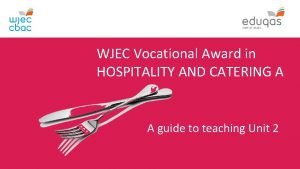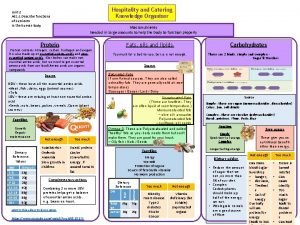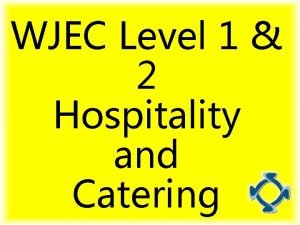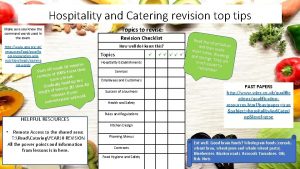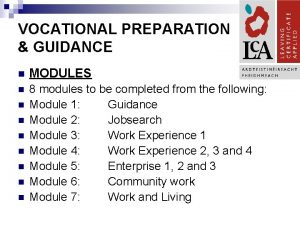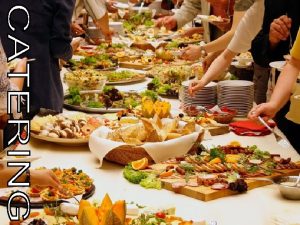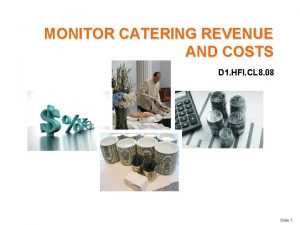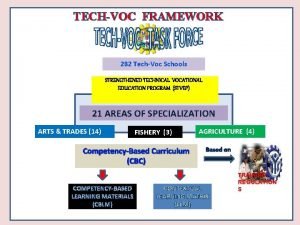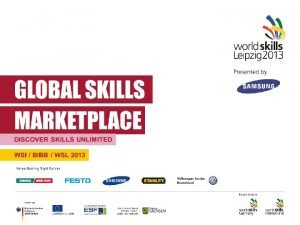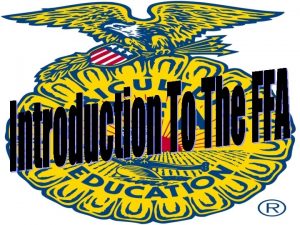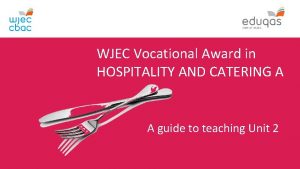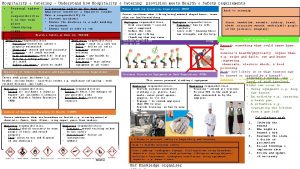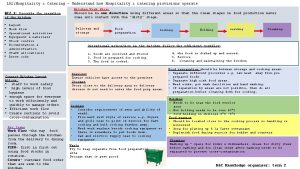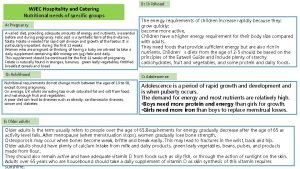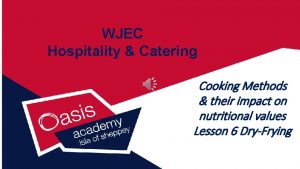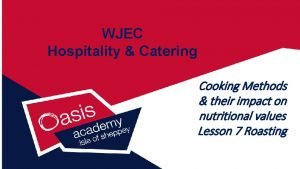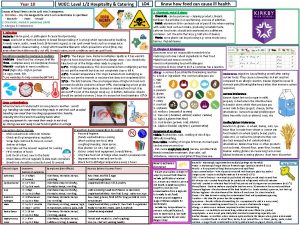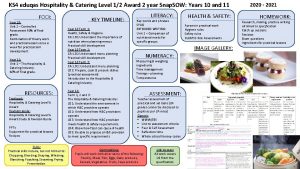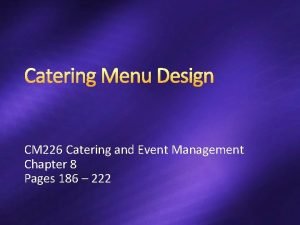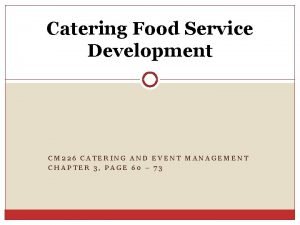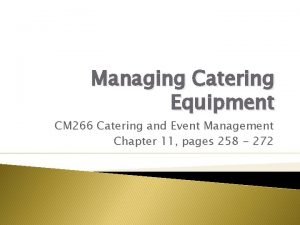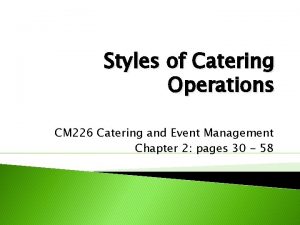WJEC Vocational Award in HOSPITALITY AND CATERING A


































- Slides: 34

WJEC Vocational Award in HOSPITALITY AND CATERING A A guide to teaching Unit 2

With the break down of command words this will fit in well with vocational aspect of the course and give more detailed instructions to center's and candidates. Work can be produced in a number of ways: Power. Point, leaflets, posters, talks (video evidence) word doc. Command words and meaning. How to produce work?

Command word Meaning L 2 D: In-depth All major points covered to demonstrate “In depth”. Covering all of the main content. L 2 M: Clear/clearly Clearly. Easy to understand. To the point. In way that is easy to see or understand. Covering most of the “main content”. L 2 P: Some Adverb: “small amount” or not all L 2 P: Evidence The available facts or information. Something that makes it plain. Or clear: indication L 1 P: Outline Without going into too much detail, this could be a simple list L 1 P: Limited range Without fullness/scope. Only covering limited parts of the assessment criteria L 1 P: Omissions left out/excluded/absent

Glossary of terms Compare To identify similarity and differences. Reasons/reasoning Similar to how/why/justify: give reasons or evidence to support your opinion or view. Explain/explanation Give reason or cause. Show understanding of how or why something has occurred. Describe Identify distinctive features and give description, factual details. Unless the word states “describe and explain”, no explanations needed for just describe. Look at it as painting a picture with words. A range A variety. Specific groups This is to be linked to the brief chosen. E. g. Western Av: elderly and Students. Dishes Meals with accompaniments. Annotated plan 3 part plan: time, method, special points and contingencies. Contingencies What to do if things go wrong. E. g. Do not over rub fat in with the flour. If I do, start again as I will have tough pastry. Skills Low, medium and high skills and how well they do it. Techniques What they do. E. g. weighing, chopping, shaping etc. Guidance With help/advice given. Precision The quality, condition, being exact and accurate.

Outline: Without going into too much detail, this could be a simple list. This could be all nutrients, however covered briefly. Level 1 at D-G grading. L 2 P: Describe: identify districted features and give descriptive, factual detail. Not all “content” needs to be covered to meet merit standard. In detail could be relating to the suggested dishes. limited range: without fullness/not all mentioned/lacks detail. Level outcome Performance band LO 1 understand the importance Assessment criteria of nutrition when planning menus. AC 1. 1 Describe functions of nutrients in the human body. Level 1 pass Level 2 Merit Outlines the functions of a limited range of nutrients in the human body. Describe functions of Describe clearly a range of nutrients functions of a range of in the human body. nutrients in the human body. Level 2 Distinction (a basic list for outline) Main content: AC 1. 1 Describe functions of nutrients in the human body. Nutrients Protein Fat Carbohydrate Vitamins Minerals Water Dietary fibre (NSP) L 2 M: Describe clearly: identify districted features and give clear descriptive, factual detail. Painting a clear picture.

This is an example of how work can be presented the majority of AC are covered in one table interlinked with candidates proposed dishes. . Proposed Dish 2 Nutrients AC 1. 1 Mighty Duck Noodles: starchy carbohydrate for energy Green pepper and chillies: peppers and chillies contain vitamin C which is good for healthy skin Carrots: Contain Vitamin A and Beta-carotene which helps with vision Duck: provides protein for growth and repair and also iron for healthy blood Vegetable and sesame oil: these provide a unsaturated form of fat which is better for your heart Soy sauce: This provides sodium which is important for the balance of your body fluid though too much can cause high blood pressure Customer Needs AC 1. 2/AC 1. 3/AC 2. 3 Success Factors AC 2. 1/AC 2. 2 Both students and elderly people need energy from food, though students may be more active and need more. A good amount of vitamins in the diet will help both groups fight illness. Students are still growing so they need plenty of protein, but elderly people also need it to repair their bodies. Iron is important to help prevent anaemia. Young women are prone to anaemia because of periods and older people because of loss of appetite or problems chewing food. Vitamin A and Beta-carotene help aid night vision. Older people may find that their vision becomes worse as they age, so this is an important vitamin to include in their diet. Unsaturated fats are better for both groups, but will still help with warmth and protection. Both groups should try to eat 5 a day to help with digestion. Noodle dishes have become more popular in recent years. The duck is an expensive ingredient, but the dish doesn’t contain a lot and the other ingredients are cheap. This dish is easy to adapt for different dietary needs. The café could use tofu instead of duck to suit vegans. The café could also offer different types of noodles, for example rice noodles which could be eaten by people with coeliac disease. The café could offer different sizes to suit all appetites. They could use local or seasonal ingredients to make them more interesting and to reduce the amount of food miles used to buy the ingredients. The café could vary the amount of chilli as some people prefer spicy food. Noodles are suitable to eat in, takeaway or deliver and could be packaged in recyclable containers. Cooking Methods / Skills AC 1. 4/AC 3. 1/AC 3. 3 This is a quick dish to make and should be made to order, so all of the ingredients must be prepared in advance. The noodles only need to be boiled for 3 minutes. The meat needs to be fully cooked before stir-frying the vegetables which should be cut thinly. Stirfrying is a healthy method of cooking which only uses a little fat and keeps most of the vitamins in the food. Food Safety AC 3. 5 The noodles should be cooked fresh for each dish because cooked noodles carry a risk of bacillus cereus food poisoning bacteria if they are left too long at room temperature. The duck needs to be fully cooked until the juice runs clear to prevent salmonella poisoning. If the food is to be taken away or delivered it should be in containers that can be reheated easily and there should be instructions for safe re-heating. The delivery van will have to have insulated boxes so that the food arrives hot.

This is another example of a different way to present the work for AC 1. 1 This chart is only for AC 1. 1, other AC covered separately

L 2 M: Describe clearly: identify districted features and give clear descriptive, factual detail. Painting a clear picture. Most of content should be covered within this section for Merit standard or clear description linked to chosen X 4 dishes. Candidates can display evidence of AC in anyway. This could be interlinked to 4 proposal dishes, poster, chart, leaflet. Proposed Dish 2 Mighty Duck Noodles Nutrients (1. 1) linked to four possible dishes Noodles: starchy carbohydrate for energy Green pepper and chillies: peppers and chillies contain vitamin C which is good for healthy skin Carrots: Contain Vitamin A and Betacarotene which helps with vision Duck: provides protein for growth and repair and also iron for healthy blood Vegetable and sesame oil: these provide a unsaturated form of fat which is better for your heart Soy sauce: This provides sodium which is important for the balance of your body fluid though too much can cause high blood pressure

Specific groups: are to be linked to the given Compare: To identify similarity and differences. brief. E. g. : Western Ave: Students and Elderly. Assessment criteria Level 1 pass Level 2 Merit Level 2 Distinction AC 1. 2 Compare nutritional Outlines nutritional needs of two specific groups. Comparison may be implied. Compare nutritional needs of two specific groups giving some reasons for similarities and differences. Compare nutritional needs of two specific groups giving clear reasons for similarity and differences. Compare nutritional needs of two specific groups giving clear and in-depth reasons for similarity and differences. needs of specific groups. L 1 P: outline: Comparison maybe implied. Not compared. Without going into too much detail, this could be a simple list. Learners must cover the main content: AC 1. 2 Compare nutritional needs of specific groups. Give some (small amount) reasons or evidence to support your opinion or view. Specific groups Different life stages Childhood Adulthood Later adulthood Special diets Medical conditions Activity levels In-depth: All major points covered. Give clear: Easy to understand. To the point. In way that is easy to see or understand. Covering most but not all of the “main content” reasons: evidence to support your opinion or view.

Proposed Dish 2 Mighty Duck Noodles Compare nutritional needs of specific groups. (1. 2) Both students and elderly people need energy from food, though students may be more active and need more. A good amount of vitamins in the diet will help both groups fight illness. Students are still growing so they need plenty of protein, but elderly people also need it to repair their bodies. Iron is important to help prevent anaemia. Young women are prone to anaemia because of periods and older people because of loss of appetite or problems chewing food. Vitamin A and Beta-carotene help aid night vision. Older people may find that their vision becomes worse as they age, so this is an important vitamin to include in their diet. Unsaturated fats are better for both groups, but will still help with warmth and protection. Both groups should try to eat 5 a day to help with digestion. This example compares the needs of the two target groups linked to a possible dish. Keywords are highlighted referring to the nutritional needs.

This example is another way in which you can present AC 1. 2 Compare nutritional needs of two specific groups.

Explain: Give reason; show understanding of how or why something has occurred. Assessment criteria Level 1 pass Level 2 Merit AC 1. 3 Explain Outlines key characteristics of unsatisfactory nutritional intake. Evidence is mainly descriptive with limited reasoning. Explain characteristics of unsatisfactory nutritional intake. There is evidence of reasoning and relating characteristics to specific groups. Explain with clear reasoning characteristics of unsatisfactory intake of a range of nutrients. Explanations are related to specific groups. characteristics of unsatisfactory nutritional intake. L 1 P: outline: Without going into too much detail, this could be a simple list. Comparison may be implied. Learners must cover the main content: Characteristics • Visible • Non-visible AC 1. 3 Explain characteristics of unsatisfactory nutritional intake. Evidence: the available facts or information. Something that makes it plain. Or clear: indication. Unsatisfactory Nutritional deficiencies Nutritional excesses Level 2 Distinction Range: A variety. Clear: Easy to understand. To the point. In way that is easy to see or understand. Covering most of the “main content” Reasoning Similar to how/why/justify: give reasons or evidence to support your opinion or view.

Proposed Dish 4 Mini Apple Tarts Nutrients AC 1. 1 AC 1. 3 Pastry: the pastry contains wheat flour, butter and trex, so this dish provides a good amount of energy from the fat and the carbohydrate. It will be made from half white and half wholemeal flour to increase the fibre content. Apple filling: the filling of each tart will be made from one whole sliced dessert apple with the skin left on. Dessert apples are naturally sweet so the café can use less sugar to make the tart healthier for the teeth of both groups. The apple skin will also add fibre and apples are a good form of soluble fibre which is good for digestion. Even though this dish has a lot of fat in the pastry, it can be rolled thin so that it reduces the amount of fat per portion. This dish contains a lot of fibre even though it is a sweet. Both groups will enjoy desserts, but need to be careful not to eat too many fatty or sugary foods, especially if they are not very active. Too many fatty and sugary foods in your diet can lead to CHD and strokes as well as obesity. It’s very easy for students to put on weight when they first move away from home and have to make all their own food choices for the first time. This example explains characteristics of unsatisfactory nutritional intake linked to a possible dish. Keywords are highlighted referring to the nutritional needs.

This example explains characteristics of unsatisfactory nutritional intake relating to the two target groups.

Explain: Give reason or cause. Show understanding of how or why something has occurred. Performance band Assessment criteria Level 1 pass Level 2 pass AC 1. 4 Explain how Outlines how cooking methods impact on nutritional value. Evidence is mainly descriptive with limited reasoning. Explains how a range of food production methods impact on nutritional value. Reasoned statements are presented. cooking methods impact on nutritional value. Level 2 Merit Level 2 Distinction Range: a variety. Learners must cover the main content: AC 1. 4 Explain how cooking methods impact on Cooking methods nutritional value. Boiling Steaming L 1 P: outline: Comparison may be implied. But Baking doesn't have to in L 1 P. Grilling Without going into too much detail, this could Stir-fry be a simple list. Roasting Poaching Reasoned: Similar to how/why/justify: give reasons or evidence to support opinion. Remember this AC is only to L 2 Pass. I would suggest these cooking methods can be linked and mentioned in the 4 dishes. Or A simple explanation list of how each food production methods could impact on nutritional value. See next slide for a variety examples.

Cooking methods Boiling Impact on nutritional value. Boiling caused a 22 percent to 34 percent loss of vitamin C. Soaking vegetables can rob them of their nutrients because many of the minerals and vitamins found in vegetables dissolve in water. In addition, the agitation caused by the boiling water can cause the vegetables to break up and the nutrients to evaporate. Steaming Baking Grilling Poaching Stir-fry Roasting Proposed Dish 1 Ham and Pineapple Pizza Cooking Methods / Skills (1. 4) The base is made from yeast dough which has to be kneaded to stretch the gluten. The base will have to be shaped into rounds and could also have a stuffed crust. The sauce will be made from tomatoes, onions, garlic and herbs and simmered until it is reduced. The toppings should be prepared and cut evenly so that they look uniform and neat on the pizza. Baking is a good way to cook without much fat, and the vegetable toppings will still retain some of their nutrients because they aren’t cooked in water. Proposal of each dish (x 4) linked neatly with cooking methods. This would meet L 2 pass Or A list with impact description on each method Or A poster or leaflet. Boiling itamin C V f o % 3 3 Destroys tural sugars a n f o s m a r g Removes 2 s Stir-fry C. Remove in m a it v f o % Destroys 24 ompounds. c g n ti h g fi r ce r 55% of can atural suga n f o g 3 s e Remov g Microwavin itamin C V f o % 8 1 Destroys r fighting e c n a c f o 4% Removes 5. compounds Steaming min C. No a it v f o s s lo nt ould help c No significa t a th s d n ompou f effect on C s only 1 g o e v o m e R. r fight cance ar natural sug

Outline: Description but without going into too much detail, this could be a simple list. Level 1 at D-G grading. Assessment criteria AC 2. 1 Explain factors to consider when proposing dishes for menus. Explain: Give reason or cause. Show understanding of how or why something has occurred. Level 1 pass Outlines factors to consider when proposing dishes for menus. There may be some omissions. Omissions: left out/excluded or absent. Level 2 pass Explains factors to consider when proposing dishes for menus. Explanation has some reasoning. Level 2 Merit Explains factors to consider when proposing dishes for menus. Explanations are clear and well-reasoned. Level 2 Distinction Learners must cover the main content: AC 2. 1 Explain factors to consider when proposing dishes for menus. Some (small amount) reasons or evidence to support your opinion or view. Factors • Time of year e. g. seasonality of commodities, seasonal events Skills of staff Equipment available Time available Type of provision e. g. service, location, size, standards Finance e. g. costs, customer needs L 2 M: Clear: identify districted features Client base and give clear descriptive, factual detail. Painting a clear picture. Most of content should be covered within this section for Merit standard or clear description linked to chosen 4 dishes.

Examples Level 1 & L 2 Pass Outlines factors to consider when proposing dishes for menus. There may be some omissions. Factors Time of year e. g. seasonality of commodities, seasonal events Skills of staff Equipment available Time available Type of provision e. g. service, location, size, standards Finance e. g. costs, customer needs Client base Proposed Dish 4 Explain factors to consider when proposing dishes for menus AC 2. 1 • Apple tart is a popular Individual dessert which would sell Apple Tarts well in the café. • They could have an offer with a cup of tea • The café could use local apples to make it cheaper • These would be easy to take away in a paper bag for recycling Proposed Dish 3 Jam Roly poly and custard Cooking Methods / Skills Food Safety • • • Wash hands • Use a green board for apples • Apple tarts are low risk food • They should be kept covered Explain factors to consider when proposing dishes for menus AC 2. 1 • Jam roly poly is a traditional pudding that will be popular with both age groups. • Jam is cheap so this dish is good for the low budget of the customers. • This dish might be more popular in the autumn and winter months Rubbing in Rolling Slicing Baking Cooking Methods / Skills Food Safety • • • Wash hands when cooking Rubbing in Rolling Filling Steaming Blending • Wear an apron • • Cover cuts Jam roly poly is low risk It should be covered The custard needs to be kept hot

Level 2 Merit Explains factors to consider when proposing dishes for menus. Explanations are clear and well-reasoned. L 2 M: Clear: identify districted features and give clear descriptive, factual detail. Painting a clear picture. Most of content should be covered within this section for Merit standard or clear description linked to chosen 4 dishes. Factors Time of year e. g. seasonality of commodities, seasonal events Skills of staff Equipment available Time available Type of provision e. g. service, location, size, standards Finance e. g. costs, customer needs Client base Proposed Explain factors to consider when Dish 1 proposing dishes for menus AC 2. 1 Pizza is a popular dish with all ages so Ham and the café should be able to sell it well. It Pineapple does not contain expensive ingredients, Pizza so the café should be able to make a profit. Pizza is easy to adapt for different dietary needs, for example, the ham could be changed to Quorn to make it more suitable for vegetarians or changed to chicken to make it suitable for religious groups. The café could offer different sizes to suit all appetites. They could use local or seasonal ingredients to make them more interesting. Pizza is suitable to eat in, takeaway or deliver. The pizzas could be baked to order and most of the ingredients could be made in advance to save time and energy. The boxes should be made of recyclable cardboard. Proposed Dish 2 Mighty Duck Noodles Cooking Methods / Skills Food Safety The base is made from yeast dough which has to be kneaded to stretch the gluten. The base will have to be shaped into rounds and could also have a stuffed crust. The sauce will be made from tomatoes, onions, garlic and herbs and simmered until it is reduced. The toppings should be prepared and cut evenly so that they look uniform and neat on the pizza. Baking is a good way to cook without much fat, and the vegetable toppings will still retain some of their nutrients because they aren’t cooked in water. The yeast dough needs to rise in a warm place, but could portioned in advance and refrigerated until needed. All meat products need to be cooked, cooled and covered. They need to be stored in the refrigerator between 0 -5 C and should be kept on the upper shelves to prevent cross contamination. The vegetables can be prepared ahead and kept in covered containers in the fridge. The tomato sauce can be made in advance and frozen until needed. It can be used cold and kept covered in the fridge. Explain factors to consider when proposing dishes for menus Cooking Methods / Skills Noodle dishes have become more popular in recent years. The duck is an expensive ingredient, but the dish doesn’t contain a lot and the other ingredients are cheap. This dish is easy to adapt for different dietary needs. The café could use tofu instead of duck to suit vegans. The café could also offer different types of noodles, for example rice noodles which could be eaten by people with coeliac disease. The café could offer different sizes to suit all appetites. They could use local or seasonal ingredients to make them more interesting and to reduce the amount of food miles used to buy the ingredients. The café could vary the amount of chilli as some people prefer spicy food. Noodles are suitable to eat in, takeaway or deliver and could be packaged in recyclable containers. This is a quick dish to make and should be made to order, so all of the ingredients must be prepared in advance. The noodles only need to be boiled for 3 minutes. The meat needs to be fully cooked before stir-frying the vegetables which should be cut thinly. Stir-frying is a healthy method of cooking which only uses a little fat and keeps most of the vitamins in the food.

Outline: Description but without going into too much detail, this could be a simple list. Level 1 at D-G grading Assessment criteria AC 2. 2 Explain how dishes on a menu address environmental issues. Level 1 pass Outlines how dishes on a menu address environmental issues. There may be some errors. Explain: Give reason. Show understanding of how or why something has occurred. Level 2 pass Level 2 Merit Explain how dishes on a menu address environmental issues. Explanation includes reasoning. Level 2 Distinction Reasoning: Similar to how/why/justify: give reasons or evidence to support opinion. Learners must cover the main content: AC 2. 2 Explain how dishes on a menu address environmental issues. Dishes Preparation and cooking methods Ingredients used Packaging Environmental issues Conservation of energy and water Reduce, reuse, recycle Sustainability e. g. food miles, provenance Remember this AC is only to L 2 Pass. I would suggest environmental issues can be linked and mentioned in the 4 dishes. Or Could be mentioned in time plan Or Explanation of reasons of choice. See next slide for a variety examples.

Proposed Dish 1 Level 2 pass Explain how dishes on a menu address environmental issues. Explanation includes reasoning. Ham and Pineapple Pizza Proposed Dish 2 Mighty Duck Noodles Success Factors Cooking Methods / Skills Food Safety Pizza is a popular dish with all ages so the café should be able to sell it well. It does not contain expensive ingredients, so the café should be able to make a profit. Pizza is easy to adapt for different dietary needs, for example, the ham could be changed to Quorn to make it more suitable for vegetarians or changed to chicken to make it suitable for religious groups. The café could offer different sizes to suit all appetites. They could use local or seasonal ingredients to make them more interesting. Pizza is suitable to eat in, takeaway or deliver. The pizzas could be baked to order and most of the ingredients could be made in advance to save time and energy. The boxes should be made of recyclable cardboard. The base is made from yeast dough which has to be kneaded to stretch the gluten. The base will have to be shaped into rounds and could also have a stuffed crust. The sauce will be made from tomatoes, onions, garlic and herbs and simmered until it is reduced. The toppings should be prepared and cut evenly so that they look uniform and neat on the pizza. Baking is a good way to cook without much fat, and the vegetable toppings will still retain some of their nutrients because they aren’t cooked in water. The yeast dough needs to rise in a warm place, but could portioned in advance and refrigerated until needed. All meat products need to be cooked, cooled and covered. They need to be stored in the refrigerator between 0 -5 C and should be kept on the upper shelves to prevent cross contamination. The vegetables can be prepared ahead and kept in covered containers in the fridge. The tomato sauce can be made in advance and frozen until needed. It can be used cold and kept covered in the fridge. Success Factors Cooking Methods/ Skills Noodle dishes have become more popular in recent years. The duck is an expensive ingredient, but the dish doesn’t contain a lot and the other ingredients are cheap. This dish is easy to adapt for different dietary needs. The café could use tofu instead of duck to suit vegans. The café could also offer different types of noodles, for example rice noodles which could be eaten by people with coeliac disease. The café could offer different sizes to suit all appetites. They could use local or seasonal ingredients to make them more interesting and to reduce the amount of food miles used to buy the ingredients. The café could vary the amount of chilli as some people prefer spicy food. Noodles are suitable to eat in, takeaway or deliver and could be packaged in recyclable containers. This is a quick dish to make and should be made to order, so all of the ingredients must be prepared in advance. The noodles only need to be boiled for 3 minutes. The meat needs to be fully cooked before stirfrying the vegetables which should be cut thinly. Stir-frying is a healthy method of cooking which only uses a little fat and keeps most of the vitamins in the food.

Outline: Description but without going into too much detail, this could be a simple list. Level 1 at D-G grading Assessment criteria AC 2. 3 Explain how menu dishes meet customer needs. Level 1 pass Outlines how menu dishes meet customer needs in general terms. Evidence is mainly descriptive with limited reasoning. Reasoned: Similar to how/why/justify: give reasons or evidence to support opinion. Explain: Give reason or cause. Show understanding of how or why something has occurred. Level 2 pass Explain how menu dishes meet needs of specified customers. Some evidence may be in general terms and descriptive. Explanation includes reasoned statements. Level 2 Merit Explain how menu dishes meet needs of specified customers. Explanations are comprehensive and credible. Level 2 Distinction Comprehensive: to include all elements/detailed. Credible: with evidence or justification Learners must cover the main content: AC 2. 3 Explain how menu dishes meet customer Needs Nutritional needs. Organoleptic Cost e. g. premium priced dishes, value for money

Proposed AC 2. 3 Explain how menu dishes meet Dish 1 customer needs Level 2 Merit Explain how menu dishes meet needs of specified customers. Explanations are comprehensive and credible. Ham and Pineapple Pizza Proposed Dish 2 Mighty Duck Noodles Pizza is a popular dish with all ages so the café should be able to sell it well. It does not contain expensive ingredients, so the café should be able to make a profit. Pizza is easy to adapt for different dietary needs, for example, the ham could be changed to Quorn to make it more suitable for vegetarians or changed to chicken to make it suitable for religious groups. The café could offer different sizes to suit all appetites. They could use local or seasonal ingredients to make them more interesting. Pizza is suitable to eat in, takeaway or deliver. The pizzas could be baked to order and most of the ingredients could be made in advance to save time and energy. The boxes should be made of recyclable cardboard. Cooking Methods / Skills (3. 4) Food Safety (2. 1 / 2. 2 / 2. 3) The base is made from yeast dough which has to be kneaded to stretch the gluten. The base will have to be shaped into rounds and could also have a stuffed crust. The sauce will be made from tomatoes, onions, garlic and herbs and simmered until it is reduced. The toppings should be prepared and cut evenly so that they look uniform and neat on the pizza. Baking is a good way to cook without much fat, and the vegetable toppings will still retain some of their nutrients because they aren’t cooked in water. The yeast dough needs to rise in a warm place, but could portioned in advance and refrigerated until needed. All meat products need to be cooked, cooled and covered. They need to be stored in the refrigerator between 0 -5 C and should be kept on the upper shelves to prevent cross contamination. The vegetables can be prepared ahead and kept in covered containers in the fridge. The tomato sauce can be made in advance and frozen until needed. It can be used cold and kept covered in the fridge. AC 2. 3 Explain how menu dishes meet customer needs Cooking Methods / Skills (3. 4) Noodle dishes have become more popular in recent This is a quick dish to make and years. The duck is an expensive ingredient, but the should be made to order, so all of dish doesn’t contain a lot and the other ingredients are the ingredients must be prepared cheap. This dish is easy to adapt for different dietary in advance. The noodles only needs. The café could use tofu instead of duck to suit need to be boiled for 3 minutes. vegans. The café could also offer different types of The meat needs to be fully noodles, for example rice noodles which could be cooked before stir-frying the eaten by people with coeliac disease. The café could vegetables which should be cut offer different sizes to suit all appetites. They could thinly. Stir-frying is a healthy use local or seasonal ingredients to make them method of cooking which only more interesting and to reduce the amount of food uses a little fat and keeps most of miles used to buy the ingredients. The café could the vitamins in the food. vary the amount of chilli as some people prefer spicy food. Noodles are suitable to eat in, takeaway or deliver and could be packaged in recyclable containers.

Outline: Description but without going into too much detail, this could be a simple list. Level 1 at D-G grading Assessment criteria AC 2. 4 Plan production of dishes for a menu. Contingencies: What to do if things go wrong. E. g. Do not over rub fat in with the flour. If I do, start again as I will have tough pastry. Performance band Level 1 pass Level 2 pass Plan outlines key actions Plan has some detail required with some omissions and is mainly and errors that require appropriate but may amendment. There is limited have some consideration of contingencies. omissions and errors that require amendment. There is some consideration of contingencies. Level 2 Merit Plan has detail with some minor omissions. Plan does not require changes to achieve planned outcome, but would benefit from minor amendments. There are well considered contingencies. content: AC 2. 4 Plan production of dishes for a menu. Omissions: left out/excluded or absent. Plan • Sequencing • Timing • Mise en place • Cooking • Cooling • Hot holding • Completion • Serving (presented as if to be served) • Waste • Equipment • Commodity quantities • Tools • Contingencies • Health, safety and hygiene • Quality points • Storage Level 2 Distinction Plan is comprehensive and detailed, incorporating well considered contingencies for most situations. Comprehensive: to include all elements/detailed. Credible: with evidence or justification.

Level 1 pass Plan outlines key actions required with some omissions and errors that require amendment. There is limited consideration of contingencies. Time. Method. 8: 30 Heat oven to 180 C/fan 150 C/gas 4. Grease and base-line 2 x 20 cm Special points. Ingredients Method 1: 30 Miese en place get your equipment needed prepare equipment on the your work surface baking tray, palette knife, vegetable knife, green and red chopping board, table spoon, grater 1: 45 Warm water and yeast in a plastic jug to activate the yeast Put white flour into in to a bowl add 1 tbsp. of oil add yeast and salt to 150 mls until dissolved 1: 50 2: 00 Non-stick round sandwich tins with baking parchment, then Don’t forget the caster sugar! lightly grease the parchment. Sift the flour and baking Divide the mixture equally. powder into a large bowl, then tip in all the other sponge Whisk until the mixture is smooth. ingredients. Using an electric whisk beat everything together until smooth. Divide the mix between the cake tins, then bake for 20 -25 mins until cooked and golden. When cool enough to handle, remove the cakes from the tins, then leave to cool completely on a rack. Place 100 g margine, 100 g caster sugar, into a mixing bowl and beat with a plastic spoon until well mixed. 3 -4 mins. Add 100 g flour and 2 beaten eggs and mix for a further 4 mins. Divide into 6 bun cases. Bake for 20 -25 mins until firm to touch. Wash up. Crush the garlic and a little salt to a paste using a pestle and mortar, or use the flat of your knife on a chopping board. Mix together with the parsley and stir in 50 ml cold water. Place the sausage meat in a food processor (if using sausages, peel away the skins), turn on to a high speed, pour the garlic-flavoured water into the mixture, then season with pepper. 2: 05 2: 10 2: 25 2: 30 2: 45 3: 10 Put the flour and margarine into the mixing bowl and rub together to form small crumbs. mix with a knife until you have a soft not sticky dough Prepare toppings Add the water and mix together using the pallet knife. Flour a worktop surface and roll out the pastry to a thin layer. Using the pallet knife or a shape cutter, cut out reasonable sized circles to fit the moulds and place into the moulds and up the sides. Push down to flatten (it doesn’t matter if there are creases on the inside – it. In the jug of milk, crack the eggs and beat gently. Add the cheese and mix using a fork or whisk. . Put ham, cheese and onion in the base. Pour the egg, milk and cheese evenly into the pastry moulds. DO NOT OVER FIL! Bake for 15 minutes until golden brown. Put onto a floured baking tray put tomato puree on top leave a gap around the edge add your grated cheese add topping s put in the oven for 20 -25 minutes gas 200 and electric 180. Special points Knead until soft Prepare toppings in miese en place

Time Level 2 Merit Plan has detail with some minor omissions. Plan does not require changes to achieve planned outcome, but would benefit from minor amendments. There are well considered contingencies. Method Special points 1: 30 2: 05 Rub in the 50 g margarine into the 200 g S. R flour Stir in 50 g of caster sugar and add 150 mls of milk 2: 10 Add in the 50 g of chosen fruit and mix together to form a soft dough On a floured surface and pat firmly into a rectangle shape about the width of your second knuckle. Use a large pastry cutter to cut circles out of the mixture. Place them on a baking tray. Beat the egg and brush the top of the scone mixture with the beaten egg. Place into the oven for 15 minutes until they are golden brown in colour Cut 150 g of block margarine into small cubes and place into a metal bowl Add 225 g plain flour to the cubed margarine and cut through the mixture with a round bladed knife Turn the mixture out onto a floured surface and roll out into a rectangle Fold the bottom third of the pastry up and fold the top, turn 90⁰ and roll out Repeat this process another 2 times and place on a plate in the fridge to chill 2: 15 2: 20 2: 21 When the scones are baked, place onto a cooling tray and allow to cool fully Add the milk into a well in the flour and butter to prevent a soggy mixture Make sure all the fruit is evenly mixed into the dough Make sure that all the scones are equally spread on the tray Make sure each scones is brushed equally Don’t take them out to early, they could become heavy Make sure that there are still small cubes left within the mixture Make sure you put cling film over the pasty before placing it in the fridge Cut them in half to allow air to flow through to the middle

Level 2 Distinction Plan is comprehensive and detailed, incorporating well considered contingencies for most situations. Time 12. 20 pm Method Mise en Place. Personal Hygiene – wash hands, remove jewellery, put on apron and hat. Fill up washing up bowl with hot soapy water. Collect tea towel, oven gloves and dishcloth. Lay table. Sanitise worktops. Get out equipment. Weigh and measure ingredients place on white trays. Pre-heat oven Gas Mark 6. Grate cheese, prepare vegetables and fruit. Grease and line sandwich tins. Special Points Use anti-bacterial soap. Wash hands thoroughly to remove dirt and bacteria. Sanitise worktops with bacterial clean to kill bacteria. Ensure all equipment is clean. Check quality of all ingredients, check use by and best before dates. Cut vegetables into uniform sized pieces so they cook evenly. Use a brown board for vegetables and red board for bacon to prevent cross-contamination. 12. 50 pm Cooking QUICHE. Make short-crust pastry; use food processor to rub fat into flour and add water by hand. Chill. Wash up. Do not over process mixture. Use chilled water. Wrap in cling film before placing in the chiller. 1. 00 pm 1. 05 pm GATEAU. Prepare sponge for gateau using the whisking method an electric hand mixer. Divide into 2 tins and bake for 10 minutes. 1. 20 pm 1. 25 pm Wash up GATEAU. Remove sponges from oven and leave to cool slightly before removing from tins. SOUP. Sauté onions and garlic for 5 minutes and add diced carrots. Service Present decorated and garnished food on table with menu. 3. . 05 pm 3. 10 pm Wash up and sanitise worktops and cooker. Leave kitchen clean and tidy. Wash up in hot, clean soapy water to kill bacteria. Leave to drain. Whisk eggs and sugar until they thick and leave a trail for 8 seconds. Fold in egg carefully. Leave to cool so that cake has time to set Sauté over a medium heat to sweat onions. Stir to prevent them browning. Make sure plates are clean. Check portion size and presentation. Wash up in hot, clean soapy water to kill bacteria. Clean cooker to remove all food scraps. Return equipment to correct place.

Candidates need to demonstrate minimum of 3 skills in preparation, 3 cooking and presentation. Level outcome LO 3 be able to cook dishes Assessment criteria AC 3. 1 Use techniques in preparation of commodities. Level 1 pass A number of techniques are used. Guidance may be required. Skill demonstrated may show limited precision and require additional time to meet minimum requirements. Some consideration given to food safety. AC 3. 1 Use techniques in preparation of commodities. Guidance: With help/advice given. Precision The quality, condition, being exact and accurate. Performance band Level 2 pass A range of techniques are used. Limited guidance is required. Skill demonstrated may show limited precision and require additional time to meet minimum requirements. Consideration to food safety given throughout. Learners must cover the main content: Techniques Weighing and measuring Chopping Shaping Peeling Whisking Melting Rub-in Sieving Segmenting Slicing Hydrating Blending Commodities Poultry Meat Fish Eggs Dairy products Cereals, flour, rice, pasta Vegetables Fruit Soya products Level 2 Merit A range of techniques are used independently with speed and precision. Consideration to food safety given throughout. Level 2 Distinction A comprehensive range of techniques are used effectively and independently with faultless speed and precision. Consideration to food safety given throughout. Independently: on their own. Speed: within allocated time.

Recipes that have one chef hat are low level skills. These recipes when made well will secure a Level 1 pass Examples Crumbles Sandwiches Pizza with ready made bases Simple salads Assembling products with ready made sauces Recipes that have two chef hats are low / medium level skills. These recipes when made well will secure a Level 2 pass Examples Ready made pastry items assembly e. g. Milles Feuilles Fruit and vegetable dishes that require even sizes e. g. julienne, macedoine. Simple cakes, cookies scones, undecorated. Pre cut meat products or simple meat dishes such as curry, bolognaise with home made sauce. Recipes that have three chef hats are medium level skills. These recipes when made well will secure a Level 2 merit Examples Cheesecakes. Home made ice cream. Simple sauces—red wine. Decorated cakes and gateaux, whisked sponge. Home made short crust pastry products, Piped potato dishes, e. g. , duchess, croquette, shepherds pie.

Recipes that have four chef hats are medium to high level skills. These recipes when made well will secure a Level 2 distinction Examples Cheesecakes—gelatine, baked. Panna cotta. Rich yeast doughs. 1 or 2 complex accompaniments/garnishes Choux buns, home made puff pastry. Tirimisu with home made sponge. Home made pasta dishes. Roux based sauces. Lyonnaise, dauphinoise potatoes. Meat and fish dishes that require changing the shape of the meat e. g. chicken kiev. Recipes that have five chef hats are high level skills. These recipes when made well will secure a Level 2 distinction star Examples De-boning/ portioning chicken. Filleting fish 3/4 complex accompaniments/garnish 2 or more high skills to make one product e. g. Gateau St Honor Presentation of dishes exemplary—clean neat presentation Chocolate run outs, spun sugar for decorated cakes. Accurate piping skills.

Assessment criteria AC 3. 2 Assure quality of commodities to be used in food preparation. Performance band Level 1 pass Level 2 pass A limited range of A range of materials are checked materials are for quality throughout independently preparation and issues checked for identified and resolved quality and with guidance. issues identified throughout preparation. Some issues resolved with guidance. Level 2 Merit All materials are independently checked for quality and issues identified throughout preparation. Issues will be resolved independently with no guidance. Level 2 Distinction Checked for Quality: In date, not damaged, stored properly. Independently: On their own. Identified: stated/seen/mentioned. Learners must cover the main content: AC 3. 2 Assure quality of commodities to be used in food preparation. Quality Smell/Aroma Touch Sight Storage Packaging Resolve: Improve/make better. Materials/commodities: Ingredients.

Assessment criteria AC 3. 3 Use techniques in cooking of commodities. Level 1 pass A number of techniques are used. Guidance may be required. Skill demonstrated may show limited precision and require additional time to meet minimum requirements. Some consideration given to food safety. Level 2 pass A range of techniques are used. Limited guidance is required. Skill demonstrated may show limited precision and require additional time to meet minimum requirements. Consideration to food safety given throughout. Level 2 Merit A range of techniques are used with limited guidance. Skills demonstrated may show limited precision or require additional time to meet minimum requirements. Consideration to food safety given throughout. Level 2 Distinction A range of techniques are used independently with speed and precision. Consideration to food safety given throughout. Independently: on their own. Learners must cover the main content: AC 3. 3 Use techniques in cooking of commodities. Techniques Guidance: With help/advice given. Precision The quality, condition, being exact and accurate. Boiling Blanching Poaching Braising Steaming Baking Roasting Grilling (griddling) Frying Chilling Cooling Hot holding Consideration: Take in to account/think about. Speed: within allocated time.

Assessment criteria AC 3. 4 Complete dishes using presentation techniques Performance band Level 1 pass Level 2 pass Dishes presented using Dishes some techniques. presented using Quality of dishes meets a range of minimum standards for techniques with appearance, smell and some precision. taste. Some guidance Quality of dishes may be required. Some exceeds some consideration given to minimum food safety. standards for appearance, smell and taste. Limited guidance required. Consideration to food safety given throughout. Level 2 Merit Dishes presented independently using a range of techniques with precision. Quality of dishes exceeds most minimum standards for appearance, smell and taste. Consideration to food safety given throughout. Learners must cover the main content: AC 3. 4 complete dishes using presentation Presentation techniques Portion control techniques Position on serving dish Garnish Creativity Guidance: With help/advice given. Precision The quality, condition, being exact and accurate. Level 2 Distinction Dishes presented independently using a range of techniques with precision. Quality of dishes exceeds minimum standards for appearance, smell and taste. Consideration to food safety given throughout. Independently: on their own. Consideration: Take in to account/think about. Speed: within allocated time.

Assessment criteria Level 1 pass Level 2 Merit AC 3. 5 Use food safety practices Uses food safety practices in preparation, cooking and completion but may require intervention. Uses food safety practices in preparation, cooking and completion with limited intervention Effectively uses food safety practices in preparation, cooking and completion. No intervention required. Level 2 Distinction Learners must cover the main content: AC 3. 5 use food safety practices This should be in relation to preparation and cooking of commodities and in relation to use of equipment Intervention: stepping in to help.
 Explain factors to consider when proposing dishes for menus
Explain factors to consider when proposing dishes for menus Wjec hospitality and catering revision
Wjec hospitality and catering revision Ac 2.2 hospitality and catering
Ac 2.2 hospitality and catering Wjec hospitality and catering
Wjec hospitality and catering Wjec level 1/2 hospitality and catering
Wjec level 1/2 hospitality and catering Catering revision
Catering revision Wjec applied science single award
Wjec applied science single award Pre award vs post award
Pre award vs post award Technical training definition
Technical training definition Vocational preparation and guidance
Vocational preparation and guidance Wjec periodic table
Wjec periodic table Wjec gce english literature
Wjec gce english literature Eduqas english language and literature
Eduqas english language and literature Eduqas product design a level
Eduqas product design a level Wjec english literature a level
Wjec english literature a level Institutional catering examples
Institutional catering examples Monitor catering revenue and costs
Monitor catering revenue and costs Advertising computer software
Advertising computer software What is career investigation
What is career investigation Society vocational institute mughalpura
Society vocational institute mughalpura Stvep curriculum
Stvep curriculum Frank parsons counseling
Frank parsons counseling New vocationalism sociology definition
New vocationalism sociology definition Types of vocational courses
Types of vocational courses Vocational school marketing
Vocational school marketing Recommendations of kothari commission on language
Recommendations of kothari commission on language Vocational rehabilitation idaho
Vocational rehabilitation idaho A sub-culture group
A sub-culture group Is emo a subculture or counterculture
Is emo a subculture or counterculture Pierson vocational high school
Pierson vocational high school Vocational profile example
Vocational profile example Secondary commission
Secondary commission Vocational service definition
Vocational service definition Jvis
Jvis Which act first developed courses in vocational agriculture
Which act first developed courses in vocational agriculture
